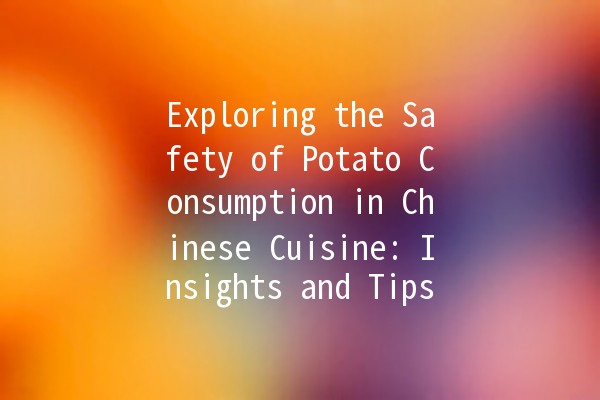Potatoes have been a staple food in many cultures worldwide, and Chinese cuisine is no exception. As the popularity of potatoes continues to grow in various dishes and dietary choices, it’s crucial to understand their safety in terms of preparation, consumption, and potential health impacts. In this article, we’ll delve into the aspects of potato safety, particularly in the context of Chinese cuisine, providing readers with tips and insights to maximize your cooking and dining experience.
Understanding the Nutritional Benefits of Potatoes
Before discussing safety, it’s essential to acknowledge the nutritional profile of potatoes. They are an excellent source of:
Complex Carbohydrates: Potatoes provide energy and keep you feeling full.
Vitamins and Minerals: Rich in Vitamin C, Vitamin B6, potassium, and dietary fiber, potatoes contribute to overall health.
Antioxidants: Potatoes contain compounds like flavonoids and carotenoids that help combat oxidative stress.
Including potatoes in your diet can be beneficial. However, it’s essential to cultivate an understanding of safety concerns surrounding their consumption.
Safety Concerns: What You Need to Know

Potatoes should be stored correctly to prevent spoilage and the development of toxins. Here are a few recommendations:
Keep They Cool and Dark: Store potatoes in a cool, dark place, ideally at temperatures between 45°F 50°F (7°C 10°C). Too much light can cause greening, which indicates the production of solanine, a potentially harmful toxin.
Avoid Refrigeration: Although tempting, refrigerating potatoes can lead to the conversion of starches into sugars, impairing flavor and texture.
Check Regularly: Regularly inspect your potatoes for signs of spoilage, such as soft spots or sprouts, which indicate that they are past their prime.
When preparing potatoes, proper cooking methods can mitigate safety risks:
Wash Thoroughly: Always wash potatoes under running water to remove dirt and potential pesticide residues.
Peeling: If the skin is green or sprouted, peel away the affected areas before consuming.
Cooking Methods: Cooking methods such as boiling, baking, or frying can minimize harmful compounds. Ensure that potatoes are cooked thoroughly to an internal temperature of at least 165°F (74°C).
While potatoes are generally safe for most people, some individuals may experience allergic reactions or food intolerances. Monitor for symptoms such as:
Skin Reactions: Rashes or hives may indicate an allergy to potatoes.
Gastrointestinal Issues: Symptoms such as bloating, gas, or diarrhea may signal an intolerance.
Should you suspect an allergy or intolerance, visiting a healthcare provider is advisable.
In Chinese cuisine, potatoes are often incorporated alongside various ingredients. Here’s how to strike a balance:
Pair with Proteins: Including lean meats or legumes can enhance the nutritional profile and satiate hunger.
Incorporate Vegetables: Mixing potatoes with a variety of colorful vegetables ensures intake of diverse vitamins and minerals.
While fresh potatoes offer numerous health benefits, processed potato products can be less healthy. For example:
Potato Chips: Often high in salt and preservatives, so moderation is key.
Canned Potatoes: May contain added sodium or preservatives, so read labels before purchasing.
Foodborne illnesses can arise from improper handling or cooking of potatoes, particularly when combined with other ingredients. To minimize risk:
Keep It Clean: Ensure your kitchen, tools, and hands are clean before preparing food.
Separate Raw and Cooked Foods: Prevent crosscontamination by using different cutting boards and utensils for raw and cooked foods.
Practical Tips for Safe Potato Consumption
Choose firm potatoes without blemishes or excess sprouts. Different varieties have unique flavors and uses, so explore options like Yukon Gold for baking or Russet for frying.
Try steaming, boiling, or roasting potatoes to maximize their health benefits. You can also innovate by incorporating spices and herbs for added flavor without excessive salt or fat.
Harness the nutritional benefits by leaving the skin on when cooking. The skin contains high amounts of fiber and nutrients, enhancing the overall health benefits.
Potatoes are high in carbohydrates, which can increase thirst. Balance your meals by staying hydrated with plenty of water throughout the day.
If you frequently consume potatoes or are concerned about their effects on your health, consider regular checkups with a healthcare professional to monitor any potential issues.
Common Questions
Yes, for most people, eating potatoes every day can be safe and beneficial. However, it's essential to prepare and consume them healthily. It’s recommended to balance your diet with a variety of foods, including other vegetables, fruits, and proteins. Moreover, pay attention to portion sizes to maintain a balanced caloric intake.
Yes, solanine is a toxin that can be harmful if consumed in large quantities. Typically, the levels found in green potatoes are enough to cause nausea, headaches, and other gastrointestinal symptoms. To prevent this, always discard green spots and avoid eating sprouted potatoes, or peel them generously.
Steaming and microwaving are excellent methods that preserve nutrients, as they reduce cooking time and moisture loss. Baking is another good option, especially when leaving the skin on. Frying, while popular, can lead to the loss of nutrients and increase the fat content.
Absolutely! The skin of potatoes contains significant amounts of fiber, vitamins, and minerals. Eating the skin can improve digestive health and provide antioxidants, which help combat free radicals in the body.
Yes, like all foods, potatoes can be contaminated with bacteria or viruses during handling. To minimize this risk, always wash potatoes thoroughly before cooking and ensure that they are cooked at the appropriate temperature.
While potatoes can have pesticide residues, washing them under running water can significantly reduce exposure. Peeling the skin can also eliminate surface contaminants. If you're concerned about pesticides, consider purchasing organic potatoes whenever possible.
These answers highlight common questions regarding potato safety, providing insight into their nutritional value and associated risks.
By understanding the safety measures and preparation tips discussed in this article, readers can enjoy potatoes as a nutritious and versatile component of their diets, particularly within the rich context of Chinese cuisine. Stay informed and prioritize safe food practices to enhance your culinary experience!